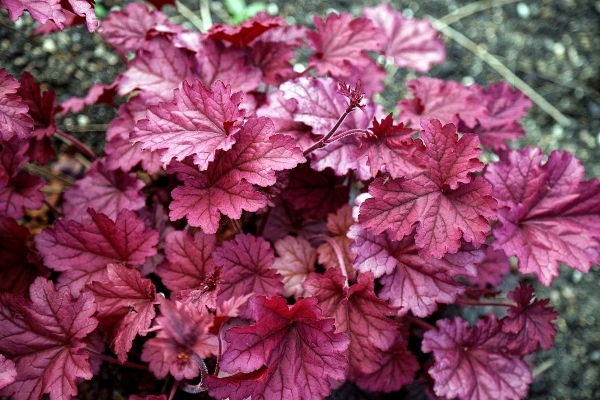
Coral Bells
Botanical Name
:
Heuchera spp.
Plant Type
:
Herbaceous perennial, ground cover
Seasons
:
Year-round; active growth and flowering from late spring to early summer.
Sun Level
:
Partial shade (3–6 hours of sun) to full shade). Some varieties develop the best leaf color in full sun, while others prefer dappled shade.
Soil Type
:
Moist, well-drained soils rich in organic matter like compost or leaf mold.
Germination
:
Propagates through division, seeds, or cuttings. Seeds may take 2–4 weeks to germinate.
P.H. Level
:
Slightly acidic to neutral (6.0–7.0)
Water/Irrigation
:
Medium water needs; prefers moist but well-drained conditions.
Fertilization
:
Not necessary unless using organic fertilizers lightly during the growing season.
Habit
:
Forms a low, rounded mound of heart-shaped or palmate leaves with varying colors such as green, silver, purple, and copper.
Final Plant Height
:
6–18 inches (15 cm–45 cm)
Spread
:
12–24 inches (30–60 cm)
Spacing
:
12–18 inches apart
Flowers
:
Small, bell-shaped, red, pink, or white flowers on tall, wiry stems in late spring to early summer.
Attracts
:
Bees, butterflies, hummingbirds
Uses
:
Borders, rock gardens, container planting, shade gardens, ground cover
Companions
:
Hydrangea, coleus, fern, hosta, astilbe, and Japanese anemone.
Pruning
:
Remove dead leaves occasionally but this isn’t essential since it remains semi-evergreen year-round. Regular division every few years helps maintain health by preventing root-bound conditions. Deadheading spent flowers encourages more blooms throughout th
Toxicity
:
Non-toxic to humans and pets.
Pests
:
Occasionally affected by weevils, aphids, and slugs
Diseases
:
Susceptible to rust, powdery mildew, and root rot if soil is too wet.
Fun Fact
:
Heuchera roots and leaves were historically used by Native Americans to treat wounds due to their astringent properties.
Botanical Name
:
Heuchera spp.
Plant Type
:
Herbaceous perennial, ground cover
Seasons
:
Year-round; active growth and flowering from late spring to early summer.
Sun Level
:
Partial shade (3–6 hours of sun) to full shade). Some varieties develop the best leaf color in full sun, while others prefer dappled shade.
Soil Type
:
Moist, well-drained soils rich in organic matter like compost or leaf mold.
Germination
:
Propagates through division, seeds, or cuttings. Seeds may take 2–4 weeks to germinate.
P.H. Level
:
Slightly acidic to neutral (6.0–7.0)
Water/Irrigation
:
Medium water needs; prefers moist but well-drained conditions.
Fertilization
:
Not necessary unless using organic fertilizers lightly during the growing season.
Habit
:
Forms a low, rounded mound of heart-shaped or palmate leaves with varying colors such as green, silver, purple, and copper.
Final Plant Height
:
6–18 inches (15 cm–45 cm)
Spread
:
12–24 inches (30–60 cm)
Spacing
:
12–18 inches apart
Flowers
:
Small, bell-shaped, red, pink, or white flowers on tall, wiry stems in late spring to early summer.
Attracts
:
Bees, butterflies, hummingbirds
Uses
:
Borders, rock gardens, container planting, shade gardens, ground cover
Companions
:
Hydrangea, coleus, fern, hosta, astilbe, and Japanese anemone.
Pruning
:
Remove dead leaves occasionally but this isn’t essential since it remains semi-evergreen year-round. Regular division every few years helps maintain health by preventing root-bound conditions. Deadheading spent flowers encourages more blooms throughout th
Toxicity
:
Non-toxic to humans and pets.
Pests
:
Occasionally affected by weevils, aphids, and slugs
Diseases
:
Susceptible to rust, powdery mildew, and root rot if soil is too wet.
Fun Fact
:
Heuchera roots and leaves were historically used by Native Americans to treat wounds due to their astringent properties.
Written by Salome Wapukha – https://www.linkedin.com/in/salome-wapukha-556700193/

